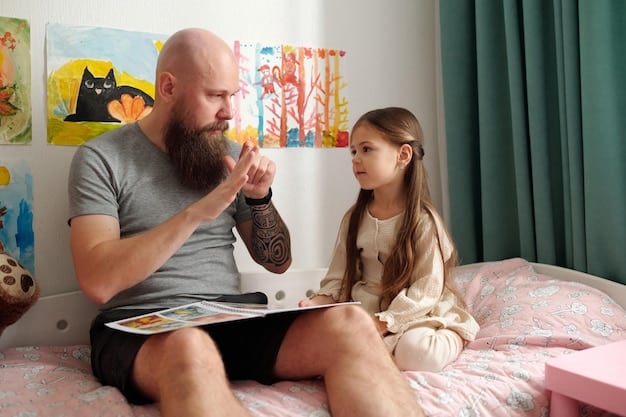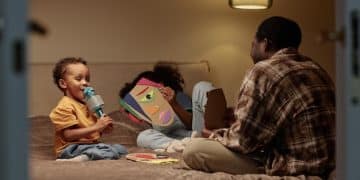Teaching Children Respect: A Father’s Guide to Responsibility & Character

Teaching your children about respect and responsibility is a crucial aspect of character development, fostering empathy, integrity, and accountability, which are essential for their future success and positive relationships.
As a father, one of the most important roles you’ll play is guiding your children to become respectful and responsible individuals. Teaching your children about respect and responsibility: A Father’s Guide to Character Development is not just about instilling good manners; it’s about nurturing their character and preparing them for a successful and fulfilling life. It’s a journey, but a rewarding one.
Why Respect and Responsibility Matter
Respect and responsibility are pivotal pillars in the construction of a child’s character. They’re not merely abstract concepts, but rather practical skills that shape how children interact with the world around them.
But what makes these two qualities so vital? It ultimately comes down to paving a path for the kids to have happy and prosperous lives. Respect and responsibility affect not only their own well-being but also the overall welfare of society.
Building Strong Relationships
Respect forms the bedrock of healthy relationships. When children learn to respect others, they are better equipped to empathize, understand different perspectives, and communicate effectively. This fosters stronger bonds with family, friends, and colleagues.
Further, responsible individuals tend to be more reliable and trustworthy, traits that garner respect from their peers and superiors. This dual effect creates a positive cycle of mutual esteem and collaborative success.

Preparing for Future Success
Beyond relationships, these qualities are essential for success in school, work, and life. Respectful children are more likely to listen to their teachers, follow instructions, and contribute positively to the classroom environment. Responsible children are more likely to complete their assignments, meet deadlines, and take ownership of their learning.
These habits translate directly into the workplace, where employers value employees who are respectful of their colleagues, customers, and company policies. Responsible employees are seen as dependable, proactive, and committed to their work, making them valuable assets to any organization.
- Respect unlocks doors: Opening up opportunities for meaningful interactions and collaborations.
- Responsibility builds trust: Fostering credibility and reliability in all endeavors.
- Together, they foster resilience: Equipping children to navigate life’s challenges with grace and perseverance.
In conclusion, teaching children respect and responsibility serves as a guiding light for their personal growth and societal contribution.
Leading by Example
Children watch our every move, absorbing our behavior like sponges. Therefore, one of the most powerful ways to instill respect and responsibility is to model these qualities ourselves.
Modeling behavior is a great way to guide children. It’s often more effective and leaves a more lasting impression than simply telling them what to do.
The Power of Observation
Children are keen observers, constantly watching and imitating the behavior of their parents. By demonstrating respect in our interactions with others, we show them what it looks like in practice.
For example, if we speak respectfully to our partners, children, and even strangers, we teach them to do the same. Conversely, if we are disrespectful, they are likely to follow suit. It is very important to be mindful of your behavior.
Actions Speak Louder Than Words
Our actions carry more weight than our words. We can tell our children to be respectful, but if we don’t show them what that looks like, our message will fall flat. We need to consistently model the behavior we want them to emulate.
Similarly, we can preach about responsibility, but if we don’t take ownership of our own mistakes or follow through on our commitments, our children won’t take our words seriously. So, it’s about showing actions and not just saying things.
So, it’s better to show them what it looks like. Make sure your own actions align with the values you want to instill in your children. Consistency is key. Make sure that you are always acting in a respectable manner.
- Show Respect: Treating everyone with dignity and consideration, regardless of their background or beliefs.
- Take Responsibility: Owning up to our mistakes and following through on our commitments.
- Be Consistent: Ensuring our actions align with the values we want to instill in our children.

In essence, we are the architects of our children’s character. By leading by example, we provide them with a blueprint for respectful and responsible living.
Open Communication and Active Listening
Effective parenting involves creating an environment where children feel comfortable expressing their thoughts and feelings. Open communication and active listening are essential tools for achieving this.
Encouraging your children to talk and actually hearing them out shows them that you value their opinions and emotions. This can strengthen your relationship and foster mutual respect.
Creating a Safe Space
To encourage open communication, it’s crucial to create a safe space where children feel free to share their thoughts and feelings without judgment. This means avoiding criticism, interruption, or dismissal, even when we disagree with them.
When children feel heard and understood, they are more likely to open up about their problems, concerns, and experiences. This not only strengthens our connection with them but also allows us to guide them more effectively.
The Art of Active Listening
Active listening involves paying attention not only to the words our children are saying but also to their body language, tone of voice, and underlying emotions. It’s about truly understanding what they’re trying to communicate, rather than simply waiting for our turn to speak.
To practice active listening, we can make eye contact, nod our heads, and ask clarifying questions. We can also reflect back what we’ve heard, using phrases like “So, what you’re saying is…” or “It sounds like you’re feeling…” This shows our children that we’re engaged and that we care about what they have to say.
Always provide your full attention when your child is speaking. Put away distractions such as phones or laptops. It is important that you are truly present.
- Listen Attentively: Giving our children our undivided attention and truly hearing what they have to say.
- Validate Feelings: Acknowledging and accepting our children’s emotions, even if we don’t understand them.
- Ask Open-Ended Questions: Encouraging our children to elaborate on their thoughts and feelings.
Ultimately, communication serves as the bridge that connects us with our children. By practicing open communication and active listening, we strengthen that bond and create a foundation of mutual respect and understanding.
Setting Clear Expectations and Boundaries
Children thrive on structure and consistency. Clear expectations and boundaries provide them with a sense of security and predictability, which are essential for their emotional well-being.
Setting clear expectations is letting your children know what is expected to their behavior and responsibility. This can encompass everything from household chores to schoolwork and social interactions.
The Importance of Consistency
Consistency is key when it comes to setting expectations and boundaries. If we constantly change the rules or make exceptions, our children will become confused and unsure of where they stand. This can lead to frustration, resentment, and even rebellion.
Therefore, it’s crucial to establish clear guidelines and stick to them as much as possible. This doesn’t mean we can’t be flexible or make adjustments when necessary, but it does mean that we should strive for consistency in our approach.
Consequences and Accountability
In conjunction with setting clear expectations, it’s important to establish consequences for when those expectations are not met. Consequences should be fair, age-appropriate, and consistently enforced.
The purpose of consequences is not to punish children but rather to teach them accountability and responsibility. When they understand that their actions have consequences, they are more likely to think before they act and make responsible choices.
The consequences should not be too severe. The goal is to teach and guide, not to punish. Make sure the consequences match the severity of the infraction.
- Establish Rules: Clearly defining what is expected of our children in various situations.
- Enforce Consequences: Consistently applying fair and age-appropriate consequences when rules are broken.
- Offer Explanations: Helping our children understand the reasons behind the rules and consequences.
All in all, setting clear expectations and boundaries provides children with a framework for responsible behavior. By being consistent and fair, we teach them to make responsible choices and take ownership of their actions.
Teaching Empathy and Compassion
Empathy and compassion are the cornerstones of a caring and connected society. Teaching children to understand and share the feelings of others is essential for their emotional and social development.
Empathy is putting yourself in someone else’s shoes. It is seeing the world from their perspective and understanding their feelings.
Understanding Others’ Perspectives
One of the most effective ways to foster empathy is to teach children to consider the perspectives of others. This involves encouraging them to think about how their actions might affect others and to imagine themselves in someone else’s situation.
We can do this by asking questions like “How do you think that made them feel?” or “What would you do if you were in their shoes?” By prompting them to think critically about others’ experiences, we help them develop a deeper understanding of human emotions.
The Power of Kindness and Service
Another powerful way to cultivate empathy and compassion is to involve children in acts of kindness and service. This could involve volunteering at a local charity, helping a neighbor in need, or simply performing a random act of kindness for a stranger.
By stepping outside of their own worlds and engaging in meaningful service, children learn to appreciate the struggles and challenges faced by others. This fosters a sense of connection and responsibility, inspiring them to become compassionate and caring members of society.
Help them to connect these lessons to real-life situations. Encourage them to reflect on how they can make a positive impact on others.
- Encourage Perspective-Taking: Helping our children understand how others might be feeling.
- Promote Acts of Kindness: Involving our children in activities that demonstrate compassion and caring.
- Model Empathy: Showing our children how to understand and respond to the emotions of others.
teaching our children will instill a sense of responsibility and understanding. Our mission is to shape children into compassionate and well-rounded individuals.
Fostering Independence and Problem-Solving
While it’s natural to want to protect our children from challenges and difficulties, it’s essential to give them the space to grow, learn, and develop their own problem-solving skills.
The ability to independently solve problems is a great gift in life. Also, knowing that they are able to overcome challenges can bring a sense of confidence to a child.
The Value of Mistakes
Mistakes are a natural part of the learning process. Instead of punishing children for making mistakes, we should view them as opportunities for growth and learning. When children are free to make mistakes without fear of judgment, they are more likely to take risks, try new things, and develop their resilience.
Mistakes provide valuable opportunities for learning. To encourage risk-taking and resilience, help them see the lessons in their mistakes.
Encouraging Critical Thinking
To foster independence and problem-solving skills, it’s crucial to encourage critical thinking. This involves teaching children to question assumptions, evaluate evidence, and consider different perspectives. We can do this by asking open-ended questions, encouraging them to think for themselves, and challenging them to defend their opinions with logic and reasoning.
It’s crucial to teach children not what to think, but how to think. Critical thinking is a skill that will serve them well in all aspects of life.
- Allow for Mistakes: Creating a safe space where children can learn from their errors.
- Encourage Exploration: Providing opportunities for our children to try new things and explore their interests.
- Promote Critical Thinking: Helping our children develop the ability to analyze information and solve problems independently.
Essentially, building independence and problem-solving skills is about empowering children to take control of their own lives and navigate the world with confidence and competence.
| Key Aspect | Brief Description |
|---|---|
| 👨🏫 Lead by Example | Model respectful and responsible behavior daily. |
| 🗣️ Open Communication | Listen actively and create a safe space for sharing. |
| ✅ Set Expectations | Define clear rules and consequences for actions. |
| ❤️ Teach Empathy | Encourage understanding and compassion for others. |
Frequently Asked Questions
▼
Teaching respect is important because it fosters positive relationships, encourages empathy, and prepares children to function effectively in diverse social and professional settings. It helps build a more harmonious community overall.
▼
You can start teaching responsibility very early in a child’s life. Begin with simple tasks like putting away toys or helping with meal preparation. As they grow, increase responsibilities to match their development level.
▼
If your child refuses responsibility, start by understanding why. Are tasks too difficult? Are they feeling overwhelmed? Adjust your approach, offer support, and ensure consequences are consistently applied following any refusal.
▼
Ensure you’re modeling respect by being mindful of your interactions. Treat all individuals with courtesy — family members, service staff, and strangers alike. Reflect on your behaviors to check for consistency in respecting others.
▼
Yes, it is essential to allow children to experience failure. Failure provides an opportunity to learn, adapt, and build resilience. Guide them through understanding what went wrong and how they can improve next time.
Conclusion
In conclusion, teaching your children about respect and responsibility: A Father’s Guide to Character Development is an investment that yields invaluable returns. By leading by example, fostering open communication, setting clear expectations and encouraging empathy, you can equip your children with the qualities they need to thrive.





